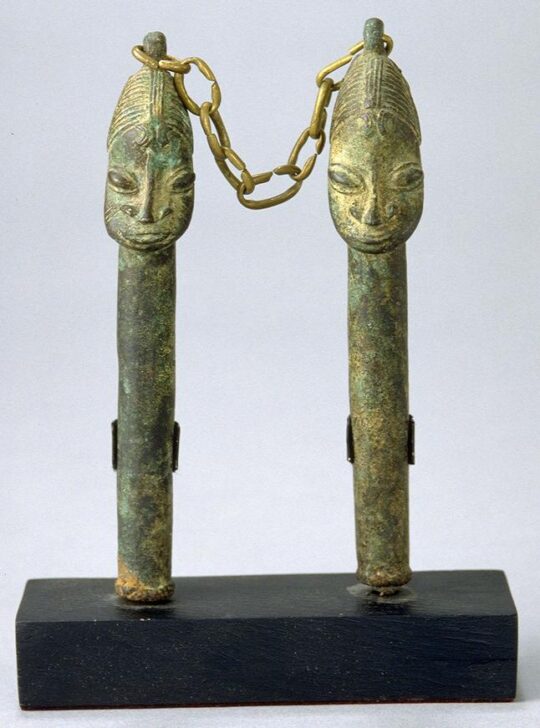Pair of Staffs
Yoruba

Description
Subject Matter:
Used by members of the Ogboni, this pair of staffs, called edan Ogboni in the Yoruba language, were worn around the neck of members to distinguish themselves in public. The Ogboni (or Osugbo) is the name of the society that mediates communication between the community and ile, the earth, according to some scholars (cf. Lawal, Yoruba, 2012, pp. 48-50; Drewal, Yoruba: Nine Centuries of African Art and Thought, 1989, p. 136-7; Thompson, Black Gods and Kings, 1971). In the pre-colonial past, the society had numerous political, judicial, and religious powers (cf. Lawal, Yoruba, 2012, pp. 48-50). Members, both men and women, selected the new king or removed a bad or unpopular one from office. While the society does not have much power today, membership is still considered prestigious (cf. Lawal, Yoruba, 2012, pp. 48-50). The pair of staffs represent the founding couple of the Ijebu Yoruba community and by extension, the male and female members of the society according to some scholars. Larger, free-standing male and female brass figures called onile also represent the founding couple (cf. Drewal, Yoruba, 1989, p. 136). According to one scholar, the earth, ile, is still a spirit, albeit one more powerful than orisas. Also called Edan, or Onílé which means "Owner of the House", was responsible for plentiful resources, peace, and happiness among humanity (cf. Lawal, Yoruba, 2012, p. 48). Following this view, the male and female figures on the staffs are an example of the Yoruba concept of èjìwàpò, meaning duality or "twoness". The staffs could refer to the Yoruba idea of the cosmos as a gourd with two halves: the male spirit world and female physical world (cf. Lawal, Èjìwàpò: The Dialectics of Twoness in Yoruba Art and Culture, p. 24-25). As the goddess of the earth, Onílé had both the power to give life as well as take it away, to be both hot and cool. Since 'cool' is associated with women and 'hot' with men, these staffs may portray the duality of Onílé (cf. Lawal, Yoruba, 2012, pp. 48-50). Despite the differences in the literature, both scholars emphasize the nakedness of the figures. The focus on sexual organs of the figures refers to procreation and the continuation of the community, while nudity is also seen as an act of honesty and openness (cf. Lawal, Yoruba, 2012, pp. 48-50; Drewal, Yoruba, 1989, p. 140).
Physical Description:
Two brass rods, each with a human head, mounted on a black, square base. On each head, there are grooved marks on the cheeks and forehead. The hair is in a conical shape with a central bar that has vertical grooves, while the rest of the hair is decorated with horizontal grooves. The two rods are connected by a gold-colored chain at the top of the heads.
Usage Rights:
If you are interested in using an image for a publication, please visit https://umma.umich.edu/request-image/ for more information and to fill out the online Image Rights and Reproductions Request Form.